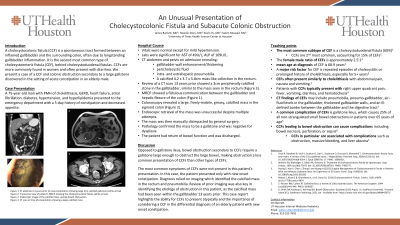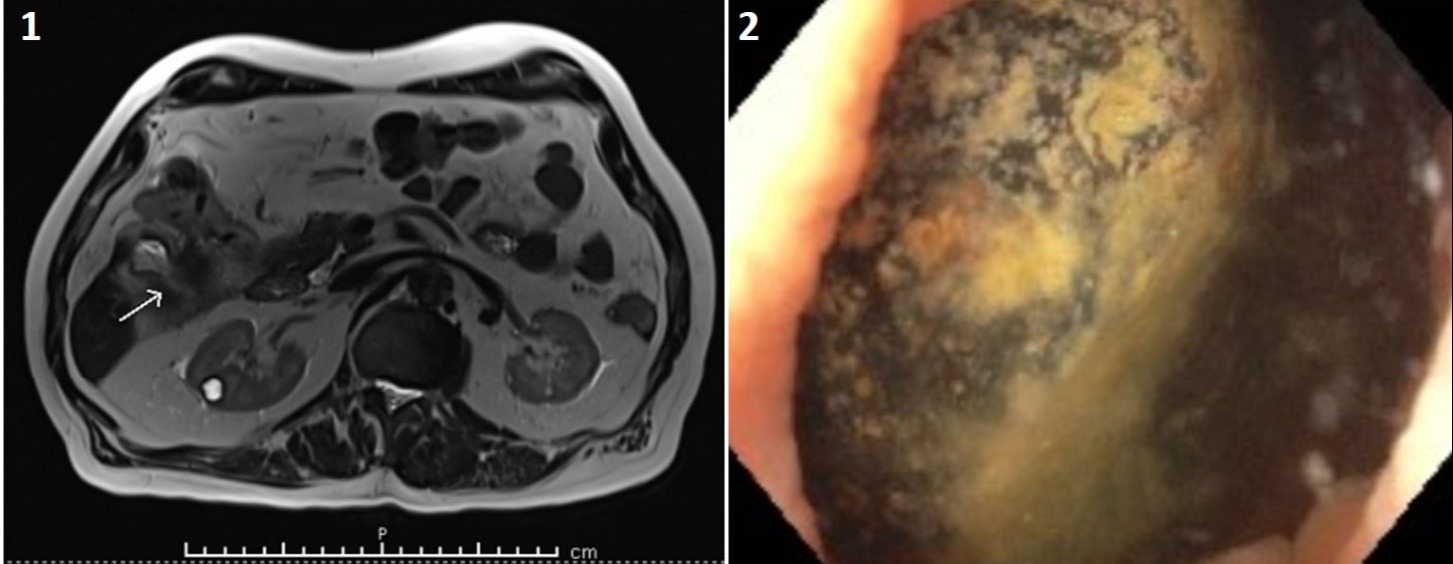Sunday Poster Session
Category: Colon
P0306 - An Unusual Presentation of Cholecystocolonic Fistula and Subacute Colonic Obstruction
Sunday, October 22, 2023
3:30 PM - 7:00 PM PT
Location: Exhibit Hall

Has Audio

James Barnett, MD
University of Texas Health Science Center at Houston
Houston, TX
Presenting Author(s)
James Barnett, MD1, Hannah Story, MD1, Kevin Yu, MD2, Salem Muayad, MD1
1University of Texas Health Science Center at Houston, Houston, TX; 2UT Health Science Center, Houston, TX
Introduction: A cholecystocolonic fistula (CCF) is a spontaneous tract formed between an inflamed gallbladder and the surrounding colon, often due to longstanding gallbladder inflammation. It is the second most common type of cholecystoenteric fistula (CEF), behind cholecystoduodenal fistulas. CCFs are more commonly found in women and often present with diarrhea. We present a case of a CCF and colonic obstruction secondary to a large gallstone discovered in the setting of acute constipation in an elderly male.
Case Description/Methods: A 75-year-old man with cholelithiasis, gastroesophageal reflux disease, heart failure, atrial fibrillation, diabetes, hypertension, and hyperlipidemia presented to the emergency department with a 5-day history of constipation and decreased appetite. Vitals were notable for mild hypertension. Abnormal labs included an AST of 49U/L and Alkaline Phosphatase of 109U/L. A CT abdomen and pelvis revealed gallbladder wall enhancement/thickening, pericholecystic fluid, intra- and extrahepatic pneumobilia, and a 4.2 x 3.7 x 5.8cm mass-like collection in the rectum. Review of a 2009 CT scan showed a 3cm peripherally calcified stone in the gallbladder, similar to the calcified mass seen in the rectum. MRCP showed a fistulous communication between the gallbladder and hepatic flexure of the colon (Figure 1). Colonoscopy revealed a large, freely-mobile, greasy, calcified mass in the sigmoid colon (Figure 2). Endoscopic retrieval of the mass was unsuccessful despite multiple attempts. The mass was then manually disimpacted by general surgery. Pathology confirmed the mass to be a gallstone and was negative for dysplasia. The patient had return of bowel function and was discharged.
Discussion: As opposed to a gallstone ileus, bowel obstruction secondary to CCFs require a gallstone large enough to obstruct the large bowel. Intestinal obstruction is therefore a less common presentation of CCFs than other types of CEFs. The most common symptoms of CCFs include diarrhea, vomiting, right upper quadrant pain, fever, and hematochezia, none of which were seen in this patient. In this case, the patient presented only with new onset constipation. Diagnosis relied on the pneumobilia seen on CT, and the calcified mass in the rectum that was later identified as a gallstone that had migrated through the CCF. This case report highlights the ability for CCFs to present atypically and the importance of considering a CCF in the differential diagnosis of an elderly patient with new onset constipation.

Disclosures:
James Barnett, MD1, Hannah Story, MD1, Kevin Yu, MD2, Salem Muayad, MD1. P0306 - An Unusual Presentation of Cholecystocolonic Fistula and Subacute Colonic Obstruction, ACG 2023 Annual Scientific Meeting Abstracts. Vancouver, BC, Canada: American College of Gastroenterology.
1University of Texas Health Science Center at Houston, Houston, TX; 2UT Health Science Center, Houston, TX
Introduction: A cholecystocolonic fistula (CCF) is a spontaneous tract formed between an inflamed gallbladder and the surrounding colon, often due to longstanding gallbladder inflammation. It is the second most common type of cholecystoenteric fistula (CEF), behind cholecystoduodenal fistulas. CCFs are more commonly found in women and often present with diarrhea. We present a case of a CCF and colonic obstruction secondary to a large gallstone discovered in the setting of acute constipation in an elderly male.
Case Description/Methods: A 75-year-old man with cholelithiasis, gastroesophageal reflux disease, heart failure, atrial fibrillation, diabetes, hypertension, and hyperlipidemia presented to the emergency department with a 5-day history of constipation and decreased appetite. Vitals were notable for mild hypertension. Abnormal labs included an AST of 49U/L and Alkaline Phosphatase of 109U/L. A CT abdomen and pelvis revealed gallbladder wall enhancement/thickening, pericholecystic fluid, intra- and extrahepatic pneumobilia, and a 4.2 x 3.7 x 5.8cm mass-like collection in the rectum. Review of a 2009 CT scan showed a 3cm peripherally calcified stone in the gallbladder, similar to the calcified mass seen in the rectum. MRCP showed a fistulous communication between the gallbladder and hepatic flexure of the colon (Figure 1). Colonoscopy revealed a large, freely-mobile, greasy, calcified mass in the sigmoid colon (Figure 2). Endoscopic retrieval of the mass was unsuccessful despite multiple attempts. The mass was then manually disimpacted by general surgery. Pathology confirmed the mass to be a gallstone and was negative for dysplasia. The patient had return of bowel function and was discharged.
Discussion: As opposed to a gallstone ileus, bowel obstruction secondary to CCFs require a gallstone large enough to obstruct the large bowel. Intestinal obstruction is therefore a less common presentation of CCFs than other types of CEFs. The most common symptoms of CCFs include diarrhea, vomiting, right upper quadrant pain, fever, and hematochezia, none of which were seen in this patient. In this case, the patient presented only with new onset constipation. Diagnosis relied on the pneumobilia seen on CT, and the calcified mass in the rectum that was later identified as a gallstone that had migrated through the CCF. This case report highlights the ability for CCFs to present atypically and the importance of considering a CCF in the differential diagnosis of an elderly patient with new onset constipation.

Figure: Figure 1. MRCP image showing the Cholecystocolonic Fistula (white arrow)
Figure 2. Endoscopic image of the calcified gallstone causing bowel obstruction
Figure 2. Endoscopic image of the calcified gallstone causing bowel obstruction
Disclosures:
James Barnett indicated no relevant financial relationships.
Hannah Story indicated no relevant financial relationships.
Kevin Yu indicated no relevant financial relationships.
Salem Muayad indicated no relevant financial relationships.
James Barnett, MD1, Hannah Story, MD1, Kevin Yu, MD2, Salem Muayad, MD1. P0306 - An Unusual Presentation of Cholecystocolonic Fistula and Subacute Colonic Obstruction, ACG 2023 Annual Scientific Meeting Abstracts. Vancouver, BC, Canada: American College of Gastroenterology.
